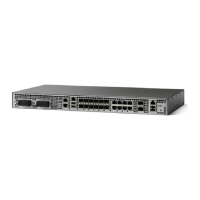MPLS Transport Profile Static and Dynamic Multisegment Pseudowires
Multiprotocol Label Switching Transport Profile (MPLS-TP) supports the following combinations of static
and dynamic multisegment pseudowires:
•
Dynamic-static
•
Static-dynamic
•
Static-static
MPLS-TP OAM Status for Static and Dynamic Multisegment Pseudowires
With static pseudowires, status notifications can be provided by BFD over VCCV or by the static pseudowire
OAM protocol. However, BFD over VCCV sends only attachment circuit status code notifications. Hop-by-hop
notifications of other pseudowire status codes are not supported. Therefore, the static pseudowire OAM
protocol is preferred
MPLS Transport Profile Links and Physical Interfaces
Multiprotocol Label Switching Transport Profile (MPLS-TP) link numbers may be assigned to physical
interfaces only. Bundled interfaces and virtual interfaces are not supported for MPLS-TP link numbers.
The MPLS-TP link creates a layer of indirection between the MPLS-TP tunnel and midpoint LSP configuration
and the physical interface. The mplstp link command is used to associate an MPLS-TP link number with a
physical interface and next-hop node. The MPLS-TP out-links can be configured only on the ethernet interfaces,
with either the next hop IPv4 address or next hop mac-address specified.
Multiple tunnels and LSPs may then refer to the MPLS-TP link to indicate that they are traversing that interface.
You can move the MPLS-TP link from one interface to another without reconfiguring all the MPLS-TP tunnels
and LSPs that refer to the link.
Link numbers must be unique on the router or node.
Tunnel Midpoints
Tunnel LSPs, whether endpoint or midpoint, use the same identifying information. However, it is entered
differently.
•
At the midpoint, all information for the LSP is specified with the mpls tp lsp command for configuring
forward and reverse information for forwarding.
•
At the midpoint, determining which end is source and which is destination is arbitrary. That is, if you
are configuring a tunnel between your device and a coworker’s device, then your device is the source.
However, your coworker considers his or her device to be the source. At the midpoint, either device
could be considered the source. At the midpoint, the forward direction is from source to destination, and
the reverse direction is from destination to source.
•
At the endpoint, the local information (source) either comes from the global device ID and global ID,
or from the locally configured information using the tp source command.
MPLS Basic Configuration Guide, Cisco IOS XE Everest 16.5.1 (Cisco ASR 900 Series)
13
MPLS Transport Profile
MPLS Transport Profile Static and Dynamic Multisegment Pseudowires

